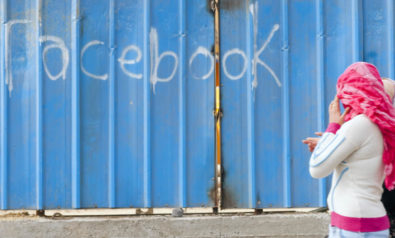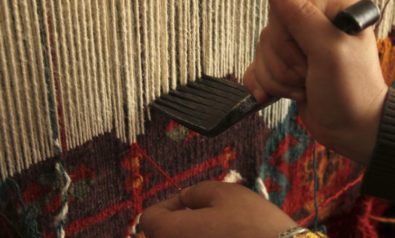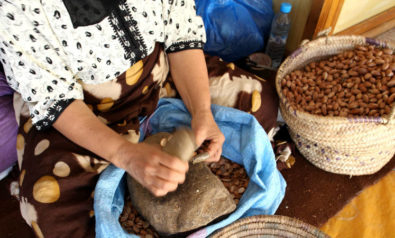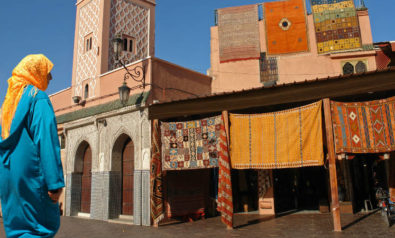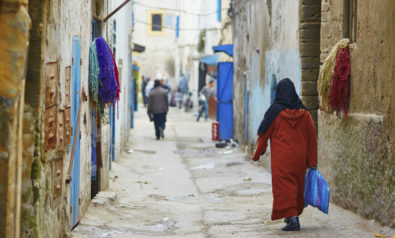Greater support for female entrepreneurship will help the MENA region achieve the Sustainable Development Goals by 2030.
The Middle East and North Africa (MENA), a region that is more often in the news for bombs and bullets than booming businesses, is experiencing a startup revolution. Nearly six years since the start of the Arab Uprisings, entrepreneurship is on the minds of those as young as 15. With unemployment and underemployment still being key factors in a region that sits on a powder keg, MENA youth are hungry to shape their own future. Alongside them, however, there is an even hungrier demographic that is having their aha moments: women.
Women entrepreneurs provide the MENA region with an economic opportunity. To understand the issue, it is important to look at the underlying problems.
THE YOUTH BULGE
As this author and Casper Wuite explained in The Arab Uprisings: An Introduction, the key catalysts behind the revolts of 2010-11 included poor economic growth, inequality, unemployment and underemployment, and poverty. When food prices go up but getting a well-paid job is like finding a needle in a haystack, frustration is bound to grow. As summed up in the book: “Stagnant economies tend to lack jobs. Most parts of the Arab world suffer from high unemployment … With no prospects for the future, it is not surprising that populations are fractious and prone to revolt.”
Despite the book being published in 2012, not much has changed. War has spread from Libya and Syria to Iraq and Yemen; disenfranchised youth across MENA have joined extremist groups while others have set sail on the migrant trail to Europe due to brain drain or conflict; and unemployment and underemployment are still rife.
Beyond the news headlines, unemployment and underemployment are the biggest issues facing the MENA region. With an immense youth bulge—half of MENA youth are under 25, which makes the region the second youngest after sub-Saharan Africa—the unemployment of young people can be a boon or bane. Discontent over government economic policy can lead to trouble. But, likewise, motivated and empowered youth can help build middle-income countries like Morocco and Jordan and high-income countries like Qatar and Saudi Arabia as they develop and diversify their economies.
INCLUSION OF WOMEN
Aside from the economic issues facing young people, however, women in MENA face an even tougher challenge. As Lama Ataya of Bayt.com notes, while the “majority of working-age women in the MENA region are educated, the majority of them remain outside the labor force.” In fact, women in the MENA region “are underrepresented in the workforce with only 25% of eligible females employed,” as Maria Khwaja notes at Fair Observer. Egypt in particular has a far higher rate of unemployed young women than men.
In no other region is the full inclusion of women needed more than the Middle East and North Africa. With the massive potential of educated women in helping to bring economic prosperity to the region, this is an area that needs closer attention.
After all, women can be change-makers for the political, economic and social development of any country. As Lakshmi Puri, deputy executive director of United Nations Women, states: “[W]omen … are game-changers in building more resilient, peaceful, inclusive and prosperous countries.” In order to the meet the Sustainable Development Goals (SDGs), which are global targets set by the United Nations for 2030, it is vital that women in MENA are included at every step of the way. When more women work—along with men—economies tend to grow.
Eric Asmar, director of programs at the Moroccan Center for Innovation and Social Entrepreneurship (Moroccan CISE), reaffirms this in an interview at the organization’s co-working hub in Rabat: “Across the board, the positive effects of women in the labor force are well-documented.”
WOMEN ENTREPRENEURSHIP IN MENA
But while the inclusion and unemployment of women is still an issue, this does not mean that women in MENA are not active players. While unemployment is holding back the economic development of the region, women (and youth) are shaping their own future by entering the start-up industry.
From Morocco and Egypt to Jordan and Qatar, entrepreneurship is seen as the new “fashion” in the region. This can be a good thing and a bad thing. If more start-ups are created, so will more jobs—and with that a more productive impact on the economy. As an added bonus, less pressure is on governments for annual job creation as they struggle to keep up the growing demands of the employment market.
At the same time, however, not all start-ups are successful. As this author was told in Amman while conducting field research for his forthcoming book, The Youth of the Middle East, countries like Jordan and Lebanon have thousands of new companies being created, but not all are active. Instead of founders creating a successful business, the firms are simply registered in the country but with no work being done.
 Fair Observer provides you deep and diverse insights for free. Remember that we still have to pay for servers, website maintenance and much more. So, donate now to keep us free, fair and independent.
Fair Observer provides you deep and diverse insights for free. Remember that we still have to pay for servers, website maintenance and much more. So, donate now to keep us free, fair and independent.
In fact, a foreign investor in Paris told this author that “most start-ups in the Middle East and North Africa that are building mobile apps are likely to fail—that’s the reality of it.” The business models are either poorly constructed or there is a metaphorical glass ceiling on how far the product can be taken. The risk here is in brain drain if an entrepreneur fails to make a buck with their business.
But while there is no guarantee that creating a company will lead to success, entrepreneurship is a field that carries much promise for the future of MENA. Despite female entrepreneurship being less common in the MENA region compared to other parts of the developing world, Yasmine El Baggari—a budding Moroccan entrepreneur and founder of Voyaj, a US-based travel startup that is winning fans at the White House—talks about the positive buzz surrounding female entrepreneurship in MENA: “After a discussion with Christopher M. Schroeder, it was clear that female entrepreneurship is thriving across the Middle East and North Africa, particularly in the technology sector. In his new book, Startup Rising: The Entrepreneurial Revolution Remaking the Middle East, Schroeder reports that over a third of startups in the region are run by women—a higher percentage than in Silicon Valley.”
Beating male-dominated Silicon Valley might not be that difficult, but the fact that the MENA region is the one that has more start-ups than the Bay Area is telling of the “revolution” that is brewing in the Middle East and North Africa.
The impact that women can have on the region’s economic situation provides light at the end of the tunnel. But their passion, drive and ability to start successful businesses are unmatched for Asmar. He says that “women are uniquely equipped to be entrepreneurs with the way they manage teams, time, finances.”
Having managed many startups as part of Moroccan CISE’s incubator program, Dare Inc., and collaborated with countless others across the region, Asmar goes on to add: “On the MENA level, we have specific challenges that women are well-equipped to address … and with many socioeconomic issues across the board, women are better equipped to bridge those gaps.”
Female entrepreneurs throughout the MENA region are as diverse as their male counterparts. From diligent designers to tech-savvy developers, women entrepreneurs “are moving across different sectors,” Asmar says. “In the previous generation, there was a division: like in women-focused fields such as food, cosmetics, textiles, artisans, handicrafts—the traditional sectors. But in the younger generation, you have women … working in agriculture, in tech.” Other fields include “consulting, communications and coaching,” as Nezha Dermoumi, the chief financial officer of Moroccan CISE, adds. The female start-up industry is clearly changing.
SOCIAL CHALLENGES FOR WOMEN ENTREPRENEURS
While female entrepreneurship does carry promise, there are significant challenges that inevitably go along with it. While global institutions like the World Bank Group’s International Finance Corporation have substantially highlighted key challenges faced by female entrepreneurs—additional training, human resources, access to finance and high costs—there are other basic issues at the social level that are often overlooked in policy reports.
Many entrepreneurs across the region have told this author that parents often do not want them to take a leap of faith and enter the start-up industry. Parents want their children to have a stable job in traditional fields—law, medicine, education—get married and have a family of their own.
Dermoumi explains this further: “In our culture we have family barriers. For our parents, success is to have a job in government or at big companies with social benefits, pensions, etc.”
Despite not being a gender-specific challenge—or even region-specific—female entrepreneurs often face added family pressure for them to get married before starting a company. Then, after marriage, there is an issue of further challenges of balancing family life with finding the time to write up business plans, as one entrepreneur in the United Arab Emirates told this author.
Yasmine El-Mehairy, co-founder of Supermama, sums it up: “Of course there is the social look of, ‘Ah she’s an entrepreneur, of course that explains why she’s not married at 30, that’s it.’”
While Dermoumi says that women entrepreneurs in general “face similar difficulties” as their male counterparts, these are added challenges. In smaller towns and cities in MENA, women face problems when some men simply do “not want to deal with them,” Dermoumi adds. This may occur when women are creating and marketing their products or services, and it may also be an issue when seeking external capital. While access to investment is a key challenge for both male and female entrepreneurs, as a 2014 Wamda report highlights, for women in smaller cities it can be even more difficult due to patriarchal conditions.
“People don’t take women seriously,” says Dermoumi. “In Casablanca and Rabat, we don’t see this that much, but in other regions that’s not the case.” In fact, this author was told by a Bahraini entrepreneur that sometimes men will not take a woman seriously unless she is wearing an abaya (long gown).
But while such challenges are context-specific and should not be generalized, as Asmar mentions, some women in the Gulf Cooperation Council (GCC) states have used these challenges to their advantage. “In Saudi Arabia,” he says, “there is a whole group of women [tech] developers who have started their own conferences—in a context where they are not even allowed to interact with men at conferences, so they create a women-only conference and use the segregation to their advantage with bringing in sponsors themselves.”
Asmar goes on to note: “There are social norms. [But remember] there are diverse contexts across the region. I have spoken to a lot of women in the region about their barriers, and many have told me, ‘what’s in my head’ and that they have the pieces necessary. Other women have other issues.”
Risk is the keyword for both male and female entrepreneurs—from San Francisco to Hong Kong. “There is a risk aversion in a lot of countries in the region: the idea that the best job is in the government, followed by a big company, and entrepreneurship is way down the line,” Asmar adds. And this is “multiplied when it comes to women, because there are social pressures to marry and to adhere to social standards,” but within social contexts of different countries.
THE NEXT STEP
So, what is needed?
Dermoumi says there needs to be increased “awareness” about the benefits of entrepreneurship when it comes to family pressure. She adds that women entrepreneurs must emphasize that they have the “ambitions to achieve [their] dreams.” The raising of awareness must, for Dermoumi (and other interviewees across MENA), involve the showcasing of “success stories.” To mention a few: Najla Al-Midfa, Manal Elattir and Yasmine El Baggari.
Constructive criticism is essential when it comes to entrepreneurship, and Asmar says that women “need the same support that any entrepreneur needs. Every entrepreneur needs a particular kind of support, but everyone needs mentoring and coaching that’s specific to their individual challenges. And I think that’s the case for women as well.”
Considering that female entrepreneurship is still lower in MENA that other parts of the developing world, more needs to be done to assist women in not only starting a business, but in starting a successful one.
Asmar is unequivocal here: “The policy changes should be focused on education to encourage entrepreneurship and larger policy questions relating to promoting entrepreneurship. So, making it easier to become an entrepreneur—facilitating the ability to start businesses, to trade, to buy shares, to invest [all have] benefits.”
Indeed, as previously mentioned, in order for the Middle East and North Africa to achieve the SDGs by 2030, women must be included and empowered in all aspects of life: political, economic and social. Asmar puts it astutely when he says: “When women participate, you see greater growth. Improving women’s education and participation in entrepreneurship and the workforce has positive effects on all of society, not just women.”
Amelia Stewart, writing for the Adam Smith Institute, says promoting entrepreneurship is essential: “Not only do more start-ups equate to more jobs for everyone, [but] firms run and owned by women are more likely to employ other educated women [than] firms run by men.” With that, the unemployment rate of women would decrease and the regional rate of gross domestic product (GDP) would increase.
Organizations like Moroccan CISE, Oasis 500 and INJAZ aim to prepare youth and women of the Middle East and North Africa to shape their future and their country’s future. Greater support for such initiatives will aid the MENA region as it seeks to achieve the Sustainable Development Goals by 2030.
The first step is providing the necessary support to women in both large and small cities. After all, small cities lay the foundations for a better society at large.
The views expressed in this article are the author’s own and do not necessarily reflect Fair Observer’s editorial policy.
Photo Credit: Petar Chernaev
Support Fair Observer
We rely on your support for our independence, diversity and quality.
For more than 10 years, Fair Observer has been free, fair and independent. No billionaire owns us, no advertisers control us. We are a reader-supported nonprofit. Unlike many other publications, we keep our content free for readers regardless of where they live or whether they can afford to pay. We have no paywalls and no ads.
In the post-truth era of fake news, echo chambers and filter bubbles, we publish a plurality of perspectives from around the world. Anyone can publish with us, but everyone goes through a rigorous editorial process. So, you get fact-checked, well-reasoned content instead of noise.
We publish 2,500+ voices from 90+ countries. We also conduct education and training programs
on subjects ranging from digital media and journalism to writing and critical thinking. This
doesn’t come cheap. Servers, editors, trainers and web developers cost
money.
Please consider supporting us on a regular basis as a recurring donor or a
sustaining member.
Will you support FO’s journalism?
We rely on your support for our independence, diversity and quality.



